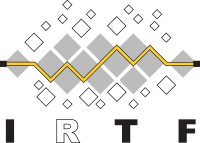The Thing-to-Thing Research Group (T2TRG) will investigate open research issues in turning a true “Internet of Things” into reality, an Internet where low-resource nodes (“things”, “constrained nodes”) can communicate among themselves and with the wider Internet, in order to partake in permissionless innovation. The focus of the T2TRG are on issues that touch opportunities for standardization in the IETF, i.e., it will start at the adaptation layer connecting devices to IP, and end at the application layer with architectures and APIs for communicating and making data and management functions (including security functions) available.
Motivation
A first wave of IoT standards has been completed by the IETF. Consortia are now forming to build infrastructure and industry agreements around those. This generates new requirements for research, based on actual usage of the standards now available.
In parallel, W3C has set up an IG (Interest Group) on the Web of Things (WoT); this is operating on a similar timeline as an RG does in the IRTF. A parallel activity associated with the IETF/IRTF can help ensure the common work does not stop at the traditional boundaries of the W3C, but considers networking issues as well. IETF WGs are also active on these topics, but an IRTF RG can provide a more long-term perspective to the collaboration.
Areas of Interest
A number of areas of interest have been identified:
- Understanding the motivation for single-purpose silos and gateways; facilitating a move towards small pieces loosely joined (hence “thing-to-thing”); enabling scaling the number of applications in a single network
- Deployment considerations; scaling considerations; cost of ownership
- Management and operation of “things”
- Lifecycle aspects (including, but not limited to, security considerations)
- Cooperation with W3C, e.g., on data models, formats, and semantics
More exploratory areas of interest include:
- Operating “things” that have multiple masters/stakeholders (including understanding role definitions of devices, owners, operators, etc.)
- Exploring the duality of state- and event-based approaches
- Aspects of distribution (cf. “fog computing”); reliability and scalability considerations
- Containerization and other forms of mobile code
Other Objectives
Besides facilitating communication between researchers in its areas of interest, T2TRG pursues a number of additional objectives:
-
Definition of “benchmark” or “reference” environments:
- to enable regular plugfests, and
- as a basis for repeatable, comparable research.
- Description of practical, real world, cross domain applications of connected “things”
- Taxonomy, technology survey, and best practice documents
- Fostering collaboration with industry fora and other organizations on networking of “things”
These objectives will be achieved making use of a close involvement between the IETF community and the T2TRG. For the IETF, some RG documents may simplify the generation of (or even serve as) use case documents or other informational references. Close contact will be maintained with the IETF’s IoT-related WGs and its IoT directorate, as well as related IRTF research groups.
Name and Organization
In the context of this RG, thing refers to a connected object that is also defined by its interface to the physical world. Some “things” may be connected only using a local interconnect, but the RG’s focus is on “things” that are part of the Internet. Not all “things” are highly constrained, but IoT architectures generally need to enable the inclusion of constrained nodes.
The Thing-to-Thing Research Group plays on a reminiscence to the End-to-End Research Group (END2END), which accompanied the evolution of the Internet for its first three decades. (The T2TRG is certainly not intended to literally exclude the communication of constrained nodes with the wider Internet or with more than one other constrained node.)
The charter of the END2END RG mentioned that “the specific topics of interest (…) have changed as network research has advanced, but it is generally concerned with end-to-end services and protocols implemented in hosts” – a focus similar to that of the T2TRG, except that the concern for packet forwarding and network building may be closer to a constrained node than it was to a traditional Internet host.
Also, T2TRG will not be a closed RG, but employ an open membership policy towards all interested researchers, taking its clues from the way that, say, the DTNRG or the ICNRG have been and are being run.
Meetings
Meetings will often take place co-located with IETF meetings, and/or with meetings of related organizations such as W3C WoT IG. Organizing Workshops at research conferences is also envisioned.
Specific meetings of the T2TRG will pick focus items that much of the discussion of the meeting should revolve around. The stated focus for the initial meetings was on three immediate areas of interest:
- Management and Operation of networks involving constrained nodes
- Security and Lifecycle aspects in constrained nodes
- REST and pub/sub: Exploring the state-event duality
Future work items may include:
-
Documents
- Guidance for designing REST-based IoT Applications (“cookbook”)
- Security considerations for the IoT
- A survey of security bootstrapping approaches
-
Activities
-
Preparing and running “plugRESTs” (with support from the documents
above, in cooperation with the
W3C IG WoT;
preparing work on reference and evaluation frameworks), eventually
leading to:
- plugRESTs: lessons learned
-
Preparing and running “plugRESTs” (with support from the documents
above, in cooperation with the
W3C IG WoT;
preparing work on reference and evaluation frameworks), eventually
leading to:
Chairs
The T2TRG is chaired by Carsten Bormann and Ari Keränen.
Mailing List
The T2TRG mailing list is t2trg@irtf.org. To subscribe or access the list archives, visit the mailman page.
Datatracker
Documents and meeting materials for the T2TRG can be found on the IETF datatracker.
Web Page
Additional T2TRG information is available at https://t2trg.github.io/.
Timeline
The T2TRG was chartered on 2015-12-02.
